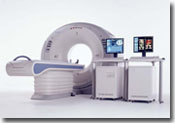
CT Scan

For your convenience and comfort, you will always be in direct communication with our technologist through an intercom and a clear glass wall.
CT scanning combines special x-ray equipment with sophisticated computers to produce multiple images or pictures of the inside of the body. These cross-sectional images of the area being studied can then be examined on a computer monitor, printed or transferred to a CD.
CT scans of internal organs, bones, soft tissue and blood vessels provide greater clarity and reveal more details than regular x-ray exams.
What are some common uses of the procedure?
CT imaging is used to:
- quickly identify injuries to the lungs, heart and vessels, liver, spleen, kidneys, bowel or other internal organs in cases of trauma.
- guide biopsies and other procedures such as abscess drainages and minimally invasive tumor treatments.
- plan for and assess the results of surgery, such as organ transplants or gastric bypass.
- stage, plan and properly administer radiation treatments for tumors as well as monitor response to chemotherapy.
- cancer staging
How should I prepare?
Metal objects including jewelry, eyeglasses, dentures and hairpins may affect the CT images and should be left at home or removed prior to your exam. You may also be asked to remove hearing aids and removable dental work.
You may be asked not to eat or drink anything for several hours beforehand, especially if a contrast material will be used in your exam. You should inform your physician of any medications you are taking and if you have any allergies. If you have a known allergy to contrast material, or "dye," your doctor may prescribe medications to reduce the risk of an allergic reaction.
Also inform your doctor of any recent illnesses or other medical conditions, and if you have a history of heart disease, asthma, diabetes, kidney disease or thyroid problems. Any of these conditions may increase the risk of an unusual adverse effect.
Women should always inform their physician and the CT technologist if there is any possibility that they are pregnant.
What does the equipment look like?
 The CT scanner is typically a large, box like machine with a hole, or short tunnel, in the center. You will lie on a narrow examination table that slides into and out of this tunnel. Rotating around you, the x-ray tube and electronic x-ray detectors are located opposite each other in a ring, called a gantry. The computer workstation that processes the imaging information is located in a separate room, where the technologist operates the scanner and monitors your examination.
The CT scanner is typically a large, box like machine with a hole, or short tunnel, in the center. You will lie on a narrow examination table that slides into and out of this tunnel. Rotating around you, the x-ray tube and electronic x-ray detectors are located opposite each other in a ring, called a gantry. The computer workstation that processes the imaging information is located in a separate room, where the technologist operates the scanner and monitors your examination.
At ViaMedica our state of the art equipment comprises the Toshiba Aquilion Premium 16 slice CT scanner.
How does the procedure work?
In many ways CT scanning works very much like other x-ray examinations. X-rays are a form of radiation-like light or radio waves — that can be directed at the body. Different body parts absorb the x-rays in varying degrees.
In a conventional x-ray exam, a small burst of radiation is aimed at and passes through the body, recording an image on photographic film or a special image recording plate. Bones appear white on the x-ray; soft tissue shows up in shades of gray and air appears black.
With CT scanning, numerous x-ray beams and a set of electronic x-ray detectors rotate around you, measuring the amount of radiation being absorbed throughout your body. At the same time, the examination table is moving through the scanner, so that the x-ray beam follows a spiral path. A special computer program processes this large volume of data to create two-dimensional cross-sectional images of your body, which are then displayed on a monitor. This technique is called helical or spiral CT.
CT imaging is sometimes compared to looking into a loaf of bread by cutting the loaf into thin slices. When the image slices are re-assembled by computer software, the result is a very detailed multidimensional view of the body's interior.
Refinements in detector technology allow new CT scanners to obtain multiple slices in a single rotation. These scanners, called "multislice CT" or "multidetector CT," allow thinner slices to be obtained in a shorter period of time, resulting in more detail and additional view capabilities. At ViaMedica our CT scanner is a multidetector 16 slice machine.
Modern CT scanners are so fast that they can scan through large sections of the body in just a few seconds. Such speed is beneficial for all patients but especially children, the elderly and critically ill.
For children, the CT scanner technique will be adjusted to reduce the radiation dose.
For some CT exams, a contrast material is used to enhance visibility in the area of the body being studied.
How is the CT scan performed?
The technologist begins by positioning you on the CT examination table, usually lying flat on your back or possibly on your side or on your stomach. Straps and pillows may be used to help you maintain the correct position and to hold still during the exam.
For children who cannot hold still for the examination, sedation may be needed. Motion will degrade the quality of the examination the same way that it affects photographs.
If contrast material is used, it will be swallowed, injected through an intravenous line (IV) or administered by enema, depending on the type of examination.
Next, the table will move quickly through the scanner to determine the correct starting position for the scans. Then, the table will move slowly through the machine as the actual CT scanning is performed.
You may be asked to hold your breath during the scanning. Any motion, whether breathing or body movements, can lead to artifacts on the images. This is similar to the blurring seen on a photograph taken of a moving object.
When the examination is completed, you will be asked to wait until the technologist verifies that the images are of high enough quality for accurate interpretation.
CT scanning of the body is usually completed within 30 minutes.
What will I experience during and after the procedure?
CT exams are generally painless, fast and easy. With helical CT, the amount of time that the patient needs to lie still is reduced.
Though the scanning itself causes no pain, there may be some discomfort from having to remain still for several minutes. If you have a hard time staying still, are claustrophobic or have chronic pain, you may find a CT exam to be stressful. The technologist or nurse, under the direction of a physician, may offer you a mild sedative to help you tolerate the CT scanning procedure.
If an intravenous contrast material is used, you will feel a slight pin prick when the needle is inserted into your vein. You may have a warm, flushed sensation during the injection of the contrast materials and a metallic taste in your mouth that lasts for a few minutes. Some patients may experience a sensation like they have to urinate but this subsides quickly.
If the contrast material is swallowed, you may find the taste mildly unpleasant; however, most patients can easily tolerate it. You can expect to experience a sense of abdominal fullness and an increasing need to expel the liquid if your contrast material is given by enema. In this case, be patient, as the mild discomfort will not last long.
When you enter the CT scanner, special lights may be used to ensure that you are properly positioned. With modern CT scanners, you will hear only slight buzzing, clicking and whirring sounds as the CT scanner revolves around you during the imaging process.
You will be alone in the exam room during the CT scan. However, the technologist will be able to see, hear and speak with you at all times.
With pediatric patients, a parent may be allowed in the room but will be required to wear a lead apron to minimize radiation exposure.
After a CT exam, you can return to your normal activities. If you received contrast material, you may be given special instructions.
Who interprets the results and how do I get them?
A specialized radiologist will analyze the images and send a signed report to the physician who referred you for the exam, who will discuss the results with you.
What are the benefits vs. risks?
Benefits
- CT scanning is painless, noninvasive and accurate.
- A major advantage of CT is its ability to image bone, soft tissue and blood vessels all at the same time.
- Unlike conventional x-rays, CT scanning provides very detailed images of many types of tissue as well as the lungs, bones, and blood vessels.
- CT examinations are fast and simple; in emergency cases, they can reveal internal injuries and bleeding quickly enough to help save lives.
- CT has been shown to be a cost-effective imaging tool for a wide range of clinical problems.
- CT is less sensitive to patient movement than MRI.
- CT can be performed if you have an implanted medical device of any kind, unlike MRI.
- CT imaging provides real-time imaging, making it a good tool for guiding minimally invasive procedures such as needle biopsies and needle aspirations of many areas of the body, particularly the lungs, abdomen, pelvis and bones.
- A diagnosis determined by CT scanning may eliminate the need for exploratory surgery and surgical biopsy.
- No radiation remains in a patient's body after a CT examination.
- X-rays used in CT scans usually have no immediate side effects.
Risks
- There is always a slight chance of cancer from excessive exposure to radiation. However, the benefit of an accurate diagnosis far outweighs the risk.
- The effective radiation dose from this procedure ranges from approximately 2 to 10 mSv, which is about the same as the average person receives from background radiation in 8 months to 3 years time.
- Women should always inform their physician and x-ray or CT technologist if there is any possibility that they are pregnant.
- CT scanning is, in general, not recommended for pregnant women unless medically necessary because of potential risk to the baby.
- Nursing mothers should wait for 24 hours after contrast material injection before resuming breast-feeding.
- The risk of serious allergic reaction to contrast materials that contain iodine is extremely rare, and radiology departments are well-equipped to deal with them.
- Because children are more sensitive to radiation, they should have a CT study only if it is essential for making a diagnosis and should not have repeated CT studies unless absolutely necessary.
What are the limitations of CT Scanning of the Body?
Soft-tissue details in areas such as the brain, internal pelvic organs, knee or shoulder can be more readily and clearly seen with magnetic resonance imaging (MRI). The exam is not generally indicated for pregnant women.
A person who is very large may not fit into the opening of a conventional CT scanner or may be over the weight limit for the moving table which is usually about 204.5 kgs (450 lbs).

